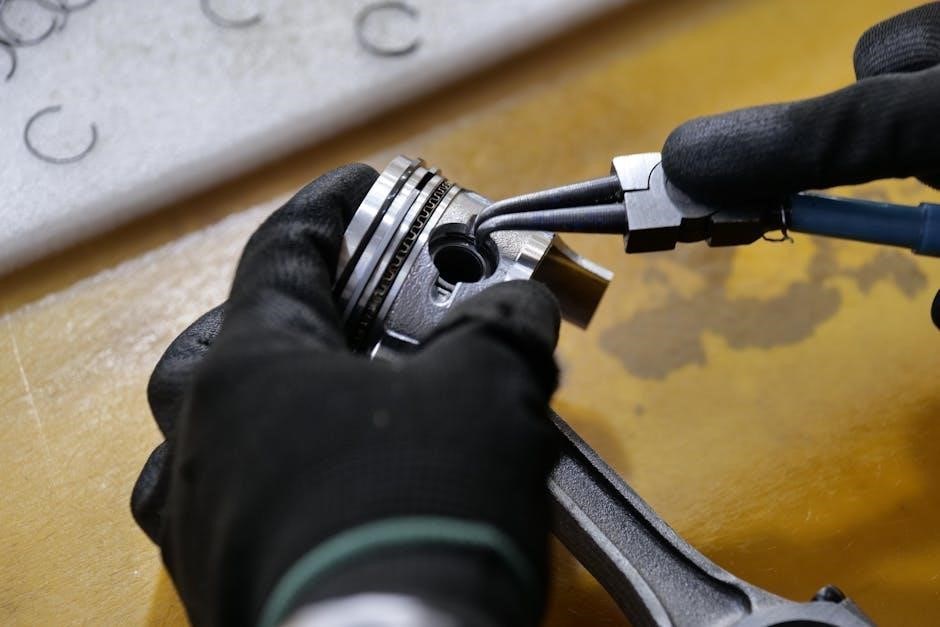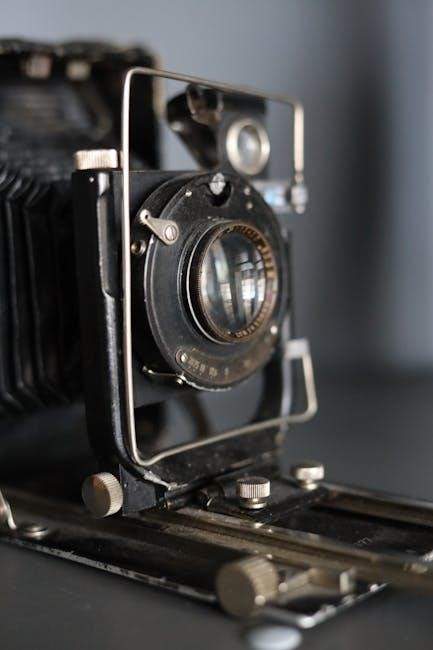Welcome to the Chicco NextFit user manual. This guide ensures safe and proper installation, covering key features, adjustments, and maintenance for optimal child safety and comfort.
Overview of the Chicco NextFit Car Seat
The Chicco NextFit is a high-quality, convertible car seat designed for safety, comfort, and versatility. It accommodates children from infancy through toddlerhood, supporting rear-facing and forward-facing positions. With its advanced features like a 9-position headrest, 2-position backrest, and SuperCinch LATCH tightening, it ensures a secure and customizable fit. The seat is built with a steel-reinforced frame and energy-absorbing foam for superior protection. Its zip feature simplifies installation, while the adjustable harness and seat depth promote proper growth alignment. This car seat is a reliable choice for parents seeking durability, ease of use, and exceptional safety for their children.
Importance of Reading the User Manual
Reading the Chicco NextFit user manual is crucial for ensuring your child’s safety and maximizing the seat’s functionality. Proper installation and adjustment are essential to meet safety standards. The manual provides detailed instructions for rear-facing and forward-facing configurations, as well as guidance on harness and headrest adjustments. It also covers troubleshooting common issues and maintenance tips. By following the manual, you can ensure compliance with safety regulations and make informed decisions about your child’s seating arrangement. The manual is a comprehensive resource designed to help you use the car seat confidently and effectively, protecting your child during every journey.

Key Features of the Chicco NextFit
The Chicco NextFit boasts an array of innovative features designed for safety, comfort, and convenience. Its adjustable headrest and shoulders ensure proper fit as your child grows, while the 9-position headrest adjustment allows for precise customization. The zip feature simplifies installation, and the SuperCinch LATCH system ensures a secure fit in your vehicle. These features work together to provide a safe, comfortable, and adaptable seating solution for your child, making the NextFit a trusted choice for parents seeking reliability and ease of use.

Key Features and Benefits
The Chicco NextFit offers advanced safety and comfort features, including an adjustable headrest, 9-position adjustment, and a zip feature for easy installation, ensuring optimal protection and convenience.

Adjustable Headrest and Shoulders
The Chicco NextFit features an adjustable headrest and shoulders, providing a customizable fit for your child. This ensures proper support and alignment for their head, neck, and shoulders as they grow. The headrest can be easily adjusted to accommodate different heights and positions, while the shoulder straps can be tightened or loosened to achieve the perfect fit. This feature not only enhances comfort but also ensures that your child is securely and safely positioned in the car seat. Proper adjustment is crucial for maximizing safety and is made simple with the intuitive design of the NextFit.
9-Position Headrest Adjustment
The Chicco NextFit offers a 9-Position Headrest Adjustment, ensuring a precise fit as your child grows. This feature allows you to customize the headrest height to match your child’s needs, providing optimal support and alignment. The easy-to-use adjustment mechanism makes it simple to position the headrest correctly, ensuring the harness sits properly on your child’s shoulders. This adaptability is crucial for maintaining safety and comfort over time. The 9-position adjustment ensures that the headrest grows with your child, offering long-lasting protection and convenience. Proper alignment is key to maximizing the effectiveness of the car seat, and this feature makes it effortless to achieve.
2-Position Backrest
The Chicco NextFit features a 2-Position Backrest designed to accommodate your child’s growth. This adjustable backrest provides two distinct positions, allowing you to customize the seat depth and support based on your child’s size and comfort needs. The first position is ideal for younger children, offering a more compact fit, while the second position provides additional legroom for older or taller kids. This feature ensures proper alignment of the harness and headrest, maintaining safety and comfort as your child grows. The 2-Position Backrest is easy to adjust, making it a practical solution for long-term use. It ensures the car seat remains a perfect fit throughout various stages of your child’s development.
Zip Feature for Easy Installation
The Chicco NextFit Zip feature simplifies installation by allowing quick and secure adjustments. This innovative design enables easy positioning and tightening of the car seat, ensuring a snug fit in your vehicle. The zip feature helps eliminate installation hassles, providing a stress-free experience for parents. It enhances safety by ensuring proper alignment and stability, while also saving time during adjustments. This user-friendly mechanism is a standout feature, making the NextFit a practical choice for families seeking convenience without compromising on safety. The zip feature is designed to streamline the installation process, ensuring confidence in every adjustment.

Safety Features
The Chicco NextFit prioritizes child safety with advanced features like SuperCinch LATCH, 360-degree protection, energy-absorbing foam, and a steel-reinforced frame, ensuring maximum security in various crash scenarios.
SuperCinch LATCH Tightening
The SuperCinch LATCH Tightening system provides a secure and easy installation process. It ensures the car seat is tightly fastened to the vehicle, minimizing movement and enhancing safety. This feature is designed to simplify the installation, reducing the risk of errors. By tightening the LATCH straps evenly, it creates a stable base for the seat, offering peace of mind for parents. The system is efficient and reliable, making it a standout feature of the Chicco NextFit car seat.
360-Degree Protection
The Chicco NextFit offers 360-Degree Protection, ensuring comprehensive safety for your child. This advanced feature provides superior protection from all angles, absorbing crash forces and reducing impact. The seat’s design, combined with energy-absorbing materials, safeguards against side, front, and rear collisions. It also includes reinforced structural elements to maintain integrity during an accident. This feature prioritizes your child’s head, neck, and body protection, giving parents peace of mind. The 360-Degree Protection is a testament to Chicco’s commitment to innovative and reliable safety solutions.
Energy-Absorbing Foam
The Chicco NextFit incorporates energy-absorbing foam to enhance safety and comfort. This foam is strategically placed to absorb and distribute crash forces, reducing the impact on your child. It works alongside the seat’s steel-reinforced frame to provide exceptional protection. The foam’s design ensures that energy is absorbed efficiently, minimizing the risk of injury. This feature is a critical component of the car seat’s safety system, ensuring your child is protected in the event of a collision. The energy-absorbing foam is a testament to Chicco’s dedication to creating safe and reliable car seats for children.
Steel-Reinforced Frame
The Chicco NextFit features a steel-reinforced frame, designed to provide unparalleled strength and durability. This robust structure ensures the seat remains stable during impacts, protecting your child from crash forces. The steel frame works in tandem with the energy-absorbing foam to create a secure and resilient safety system. Its durability also ensures long-lasting performance, supporting your child as they grow. The steel-reinforced frame is a key element in the NextFit’s ability to meet rigorous safety standards, offering peace of mind for parents seeking reliable protection for their children.

Installation Guide
The Chicco NextFit installation guide provides clear steps for securing the car seat in your vehicle. Always check your vehicle’s manual for compatibility and proper placement.
Rear-Facing Installation
For Rear-Facing Installation of the Chicco NextFit, position the car seat in your vehicle with the infant facing the rear. Ensure the base is level and securely fastened using the LATCH system or a vehicle seatbelt. Tighten the LATCH straps firmly using the SuperCinch feature for a snug fit. Check the seat’s angle indicator to confirm it’s within the recommended 45-degree range. Always refer to your vehicle’s manual for specific installation guidelines and ensure the car seat is tightly secured before use. Follow the manufacturer’s instructions carefully to guarantee your child’s safety. Regularly inspect the installation to ensure it remains secure and properly aligned.
Forward-Facing Installation
For Forward-Facing Installation of the Chicco NextFit, place the car seat in your vehicle with the child facing forward. Use the LATCH system or a vehicle seatbelt to secure the seat. Position the base firmly and ensure it is level. Tighten the LATCH straps or seatbelt until the seat is snug against the vehicle seat. Adjust the headrest to align with your child’s shoulders and head. Always check the vehicle owner’s manual for specific installation instructions. Ensure the car seat is tightly secured and properly aligned before placing your child in it. Verify the fit by shaking the seat gently—it should not move more than one inch side to side or front to back.
Vehicle Compatibility
Ensure your vehicle is compatible with the Chicco NextFit car seat before installation. Refer to both the car seat manual and your vehicle’s owner’s manual for compatibility details. The NextFit is designed to fit most vehicles, including sedans, SUVs, and trucks. Check the seat dimensions to ensure proper fit in your vehicle. Avoid vehicles with overly contoured seats or active headrests that may interfere with installation. Test the car seat in your vehicle if possible to confirm compatibility. Proper fit is crucial for safety, so ensure the car seat aligns well with your vehicle’s seating configuration.

Adjusting the Car Seat
Proper adjustment ensures your child’s safety and comfort. Adjust the harness, headrest, and seat depth as your child grows. Use the manual’s guidance for precise fitment.
Adjusting the Harness
To adjust the harness, ensure it fits snugly around your child. Loosen the harness straps, position your child, then tighten evenly. The harness should sit at or below the shoulders. Check for proper fit by ensuring no slack remains. Regularly verify that the harness is not too loose or tight, as your child grows. Always refer to the manual for detailed steps to ensure safety and comfort. Proper harness adjustment is crucial for optimal protection in the event of sudden stops or collisions.
Adjusting the Headrest
To adjust the headrest, squeeze the handle on the back of the seat and move it up or down to fit your child’s height. Ensure the headrest is level with your child’s ears for proper support. The Chicco NextFit features a 9-position adjustable headrest, allowing for a customized fit as your child grows. Always check that the headrest is securely locked in place after adjustment. For detailed steps, refer to the manual. Proper headrest alignment ensures your child’s safety and comfort, providing optimal protection in various seating positions.

Adjusting the Seat Depth
To adjust the seat depth on the Chicco NextFit, locate the adjustment handle at the base. Pull it to move the seat backward for taller children or forward for shorter ones. Ensure proper thigh support without discomfort. After adjusting, rock the seat gently to confirm stability and recheck the installation in the vehicle for safety. Regular adjustments are crucial as your child grows to maintain comfort and protection.

Maintenance and Cleaning
Regular maintenance ensures the Chicco NextFit remains safe and hygienic. Clean fabric with mild soap and water, avoiding harsh chemicals. Replace worn parts promptly and store the seat in a dry, cool area when not in use. Always refer to the manual for detailed cleaning instructions to maintain safety and longevity.
Cleaning the Car Seat Fabric
To clean the Chicco NextFit car seat fabric, use mild soap and warm water. Spot-clean stains with a damp cloth, avoiding harsh chemicals. Rinse with a clean, damp cloth to remove soap residue. Allow the fabric to air dry completely, away from direct sunlight, to prevent fading. Regular cleaning maintains hygiene and safety. Avoid machine washing, as it may damage the fabric. Always refer to the manual for specific cleaning recommendations to ensure the seat remains safe and durable for your child’s use. Proper maintenance extends the lifespan of the car seat.
Cleaning the Harness
Clean the Chicco NextFit harness using mild soap and warm water. Dampen a soft cloth and gently wipe away dirt or stains. Avoid using harsh chemicals or abrasive cleaners, as they may damage the materials. Rinse thoroughly with a clean, damp cloth to remove soap residue. Allow the harness to air dry completely to prevent moisture buildup. Regular cleaning ensures the harness remains safe and comfortable for your child. Avoid machine washing or soaking the harness, as this could compromise its integrity. Always follow the manual’s cleaning instructions to maintain the seat’s functionality and safety. Proper care extends the lifespan of the harness.
Storage and Maintenance Tips
Proper storage and maintenance are crucial for the longevity and safety of your Chicco NextFit car seat. Store the seat in a dry, cool place, away from direct sunlight and extreme temperatures. Before storing, clean the seat thoroughly and ensure all parts are dry to prevent mold or mildew. Check the expiration date on the seat and replace it if necessary. Avoid making any alterations to the seat, as this can compromise its safety. For long-term storage, keep the seat in its original packaging if possible. Always consult the user manual for detailed maintenance and storage guidelines to ensure optimal condition and safety.

Troubleshooting Common Issues
Identify and resolve common issues with the Chicco NextFit by checking proper installation, harness tightness, and adjustments. Refer to the manual for detailed solutions and guidance.
Common Installation Issues
Common issues during Chicco NextFit installation include improper LATCH tightness, incorrect seatbelt routing, and uneven base leveling. Ensure the seat is snug and level, as outlined in the manual. Verify vehicle compatibility and consult your car’s manual for specific instructions. Avoid loose connections, as they compromise safety. If the seat moves excessively, check the LATCH or seatbelt tightness. For rear-facing installations, ensure the footrest is properly positioned. Always test the seat’s stability post-installation. Correcting these issues ensures a secure and safe fit for your child. Proper installation is crucial for maximum protection in the event of a collision.
Adjustment Problems
Adjustment issues with the Chicco NextFit often involve the harness, headrest, or seat depth. Ensure the harness straps are snug and even, avoiding slack. The headrest should align with your child’s shoulders and ears. If the headrest doesn’t adjust smoothly, check for obstructions or improper alignment. For seat depth, verify it fits your child’s body without compressing their legs. Loose or overly tight adjustments can compromise safety. Refer to the manual for guidance on proper positioning. Correcting these issues ensures a secure and comfortable fit, optimizing protection and comfort for your child during travel. Regular checks are essential for maintaining proper adjustments.
Harness and Buckle Issues
Harness and buckle problems with the Chicco NextFit can affect safety. Common issues include twisted straps, difficulty in tightening, or a stubborn buckle. Ensure straps are free from twists and properly routed through the seat. If the harness doesn’t tighten evenly, check for obstructions or incorrect routing. For buckle issues, clean any debris and ensure it clicks securely. Never force the buckle or harness, as this could damage the mechanism. If issues persist, refer to the manual or contact Chicco support. Proper harness and buckle function is critical for your child’s safety, so address any problems promptly to maintain optimal protection. Regular inspections are recommended to prevent such issues.
Final Tips for Safe and Effective Use
Always refer to the official Chicco NextFit user manual for precise instructions. Ensure proper installation by checking vehicle compatibility and following LATCH guidelines. Regularly inspect the seat for wear and tear, and clean according to the manual’s instructions. Adjust the harness and headrest as your child grows to maintain a snug, secure fit. Never allow toys or loose objects near the seat, as they may cause distractions or safety hazards. Store the manual in an accessible location for future reference. By adhering to these tips, you ensure your child’s safety and comfort during every journey.
Importance of Following the Manual
Adhering to the Chicco NextFit user manual is crucial for ensuring your child’s safety. Proper installation and adjustment techniques, as outlined in the manual, prevent potential hazards and guarantee compliance with safety standards. Neglecting the guidelines can lead to incorrect use, compromising the seat’s protective features. Regularly review the manual to stay informed about maintenance, cleaning, and troubleshooting. By following the instructions, you maximize the seat’s performance and provide your child with the highest level of protection. Consistency in adhering to the manual ensures long-term reliability and peace of mind for parents.




















